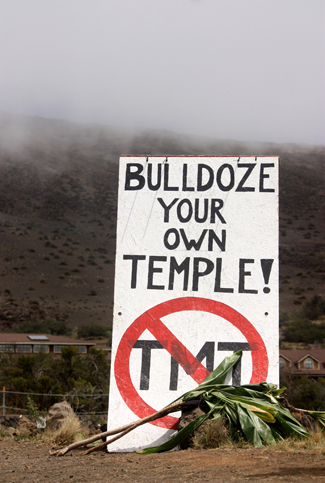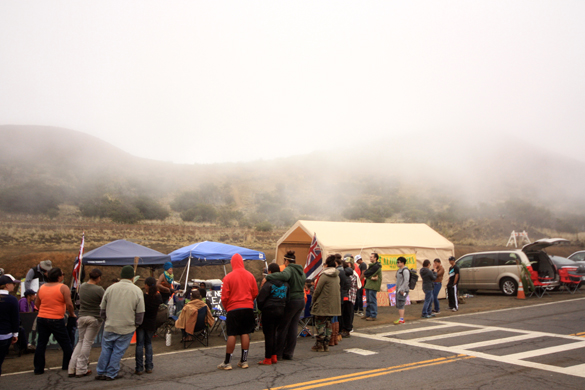Giant Telescope Project Halted on Sacred Mauna Kea; Protests Continue

After almost two weeks of Native Hawaiian demonstrations against the construction of a giant telescope on top of sacred Mauna Kea Mountain, the governor of Hawaii has called for a week’s moratorium on the project.
The demonstrations have continued and grown every day since March 30, when protesters formed a road block outside the Mauna Kea visitors’ center in Hilo, Hawaii, to prevent construction of the giant copy.4 billion Thirty Meter Telescope (TMT) by the University of Hawaii (UH).
On April 7, Gov. David Ige issued a statement announcing a time-out on the construction, Big Island Video News reported.
“Today I announced a week-long stand down of construction on the Thirty Meter Telescope so I can evaluate the situation from multiple perspectives,” Ige said. “Mahalo to TMT for its willingness to pause its activities during this time. I also thank UH President [David] Lassner and Office of Hawaiian Affairs Chair [Robert] Lindsey for their leadership on this issue. I will continue to work with them in the coming days.”

UH supports the TMT project because a telescope located on the 9,000-plus-foot high Mauna Kea (the protesters vigil is taking place at 9,000 feet) will be able to see much fainter and more distant objects than is possible with existing telescopes and to study them in greater detail. “It will help to maintain Hawaiʻi’s worldwide leadership in astronomy,” the university said in a recent posting.
Native Hawaiians believe that Mauna Kea, a dormant volcano thatis 13,796 feet above sea level, is the most sacred place on all of the islands. The snow goddess Poli´ahu is said to often descend on the mountain top, according to the University of Hawaii Institute for Astronomy.
The protesters say they are not against the science or the telescope itself, but against locating it on the sacred site.
No construction has taken place at the site since April 2 when 31 people, who call themselves the Protectors of Mauna Kea, were arrested. The arrests were carried out peacefully and with little anger, with the exception of 70-year-old Moani Akaka, who was outraged with the idea of having to be handcuffed, Big Island Video reported. Police officers seemed sympathetic to the cause, but nonetheless carried out their duty, often with the traditional Hawaiian embrace before the cuffing, according to the report. The protestors said they plan to keep a constant presence on the mountain while they try to garner more support.
Support is pouring in from around the islands and beyond, Marie Alohalani Brown, a cultural practitioner and assistant professor of religion specializing in Hawaiian and Polynesian religions, told ICTMN.
“The protest is not only ongoing, but its momentum is astonishing,” Brown said. “Those who cannot make it to the Mauna are holding protests of their own, a community effort that has galvanized hundreds of Kānaka Maoli and our supporters across Kō Hawaiʻi Pae ʻĀina (the Hawaiian islands).”
Brown said she believe the Mauna Kea movement will end up being just as momentous as the efforts in the 1970s to stop the bombing at the sacred island of Kohemalamalama, also known as Kahoʻolawe.
In that case, Kahoʻolawe, which Native Hawaiians believe is the physical incarnation of the sea god Kanaloa, was used as a bombing range by the U.S. and pounded by explosions. In 1976, Native Hawaiian activists occupied the island demanding an end to the military assault. The protest made headlines across the country. In 1990, bombing stopped and the Navy received funds to clean up the island. It was a major victory for the Native people. However, the cleanup has only been partial and other environmental problems remain.
The protest against the desecration of Mauna Kea is fueling the growing Native Hawaiian movement for full independence from the United States.
RELATED: Hawaiian Sovereignty 101: The Growing Fight for Native Independence
RELATED: Native Hawaiians maintain their inherent sovereignty
“Our Lāhui (refers to both the nation and our people) is coming together in the same way that our kūpuna (elders/ancestors) did during the Anti-Annexation movement when hundreds of ʻŌiwi (indigenous people) from across Kō Hawaiʻi Pae ʻĀina (what is called today the Hawaiian Islands) signed the petition against annexation,” Brown said, referring to the events more than 100 years ago that have left the once independent sovereign nation of Hawaii colonized and occupied, according to international law.
A joint resolution of the Senate and Congress tells the story. In 1993, President Bill Clinton signed Public Law 103-150 – an apology to the Hawaiian people for overthrowing their government and stealing their land. The apology acknowledges the illegality of the U.S. government's military-backed regime change of “the sovereign Hawaii nation” in 1893 and its support for the illegally created “provisional government” in violation of treaties and international law. The most crucial admission is the U.S. government’s acknowledgment that “the indigenous Hawaiian people never directly relinquished their claims to their inherent sovereignty as a people or over their national lands to the United States, either through their monarchy or through a plebiscite or referendum.”
The peaceful protest has been ongoing for several years but in the past several months has gathered more momentum and support from Hawaiians and other non-Hawaiians around the world.
RELATED: Videos: Hawaiian Activists Block Illegal Construction on Sacred Mountain
RELATED: Indigenous Hawaiians Fight Proposed Telescope on Sacred Mauna Kea
There is no indication about what will happen at the end of the one-week moratorium, but the protests are continuing for now. “There are several fundraising efforts to pay for trips to the island, to post bail money for arrests, to buy food, and so on,” Brown said. “So many are giving generously, even when they do not have much. … There is a carpooling FB page, and everyone is helping everyone else. … People are opening up their homes. The aloha is amazing.”

Read more at http://indiancountrytodaymedianetwork.com/2015/04/09/giant-telescope-project-halted-sacred-mauna-kea-protests-continue-159943